2011年6月28日(瑞士蘇黎世)���,在國際景觀設(shè)計(jì)師協(xié)會(huì)第48屆世界大會(huì)上�����,北京大學(xué)建筑與景觀設(shè)計(jì)學(xué)院院長(zhǎng)、土人首席設(shè)計(jì)師俞孔堅(jiān)教授做了題為“再造大地”的主旨報(bào)告����。該報(bào)告引起了轟動(dòng),被當(dāng)?shù)孛襟w稱為具有革命性的報(bào)告���,對(duì)世界景觀設(shè)計(jì)產(chǎn)生了巨大影響���。引文見外刊文章,作者:蘇珊·弗里茨(Susanne Fritz)�。 譯文如下:
俞孔堅(jiān)教授作為土人景觀的創(chuàng)始人,是世界頂尖的優(yōu)秀設(shè)計(jì)師����。他的“功能性景觀”的概念與當(dāng)代瑞士對(duì)農(nóng)業(yè)的定義驚人地一致,在瑞士很久以前農(nóng)業(yè)就不僅僅是為了提供農(nóng)產(chǎn)品而存在�����。我們的文化景觀,也就是我們所認(rèn)為的自然�,其生態(tài)和保護(hù)正在變得前所未有的更加重要。
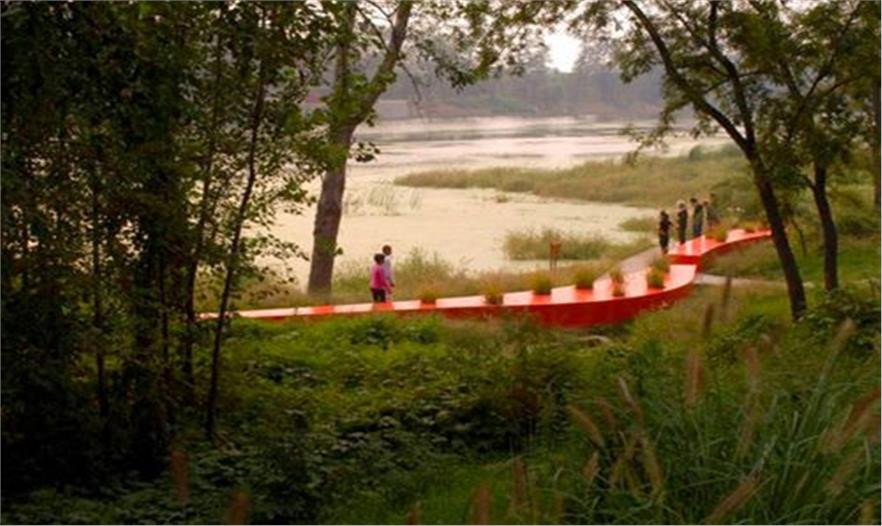
“最小的投入最大的回報(bào)”——這是對(duì)如詩般的“紅飄帶公園”最為貼切的描述����。
俞孔堅(jiān)教授從回顧個(gè)人經(jīng)歷開始,展開了他在蘇黎世市政廳的演講�。俞教授生于二十世紀(jì)六十年代的中國,來自農(nóng)村��。這樣的背景影響了他對(duì)自然和景觀的培育之間的關(guān)系的理解���。他相信���,景觀的培育只有適應(yīng)自然條件才會(huì)有好的收益,這種生態(tài)經(jīng)濟(jì)的方法����,成為了他規(guī)劃設(shè)計(jì)中最明顯的特色。
俞孔堅(jiān)曾經(jīng)是全中國幾百候選人當(dāng)中60個(gè)得到學(xué)習(xí)園林設(shè)計(jì)機(jī)會(huì)的學(xué)生之一���,諷刺的是����,他之前那些在植物方面的學(xué)習(xí)和工作經(jīng)歷與其說是為了志趣更不如說是為了謀生。直到后來在完成學(xué)業(yè)后的一次旅行當(dāng)中����,他忽然意識(shí)到環(huán)境狀況的重要性,并從此投身其中力圖找出解決問題的方法�����。后來他得以帶獎(jiǎng)學(xué)金進(jìn)入哈佛大學(xué)學(xué)習(xí)���,獲得博士學(xué)位后,這個(gè)謙遜有禮的中國人懷揣著不亞于發(fā)起一場(chǎng)“大腳革命”的決心��,躊躇滿志地回到了祖國��。

紅飄帶不僅僅是裝飾性的設(shè)施��,其目的不是去征服和禁錮自然���,而是更醒目地呈現(xiàn)自然之美���。

鑲嵌在長(zhǎng)椅內(nèi)的燈具在晚上不僅可以渲染出浪漫的氛圍,同時(shí)也保證了步道的安全。
“大腳革命”是一種借喻�����,取自中國婦女解放以后破除纏足陋習(xí)這一史實(shí)����。它基于這樣一種認(rèn)識(shí):壓制自然的文明發(fā)展意味著對(duì)資源的浪費(fèi)和揮霍。相比之下���,融合了生態(tài)學(xué)原則�,并順應(yīng)自然法則的文明發(fā)展則會(huì)更加繁榮�、多產(chǎn)。
俞孔堅(jiān)教授開創(chuàng)了一條簡(jiǎn)單但是革命性的解決之道:運(yùn)用生長(zhǎng)于當(dāng)?shù)亍胺敝沉ν⒌闹参铩边M(jìn)行大面積的造景�。這些俞孔堅(jiān)教授以“雜亂無序”形容的植物無需修剪和灌溉,它們卻有著天然的美���。向日葵和稻谷則有著象征性的特質(zhì)���,它們的果實(shí)可以被收獲。
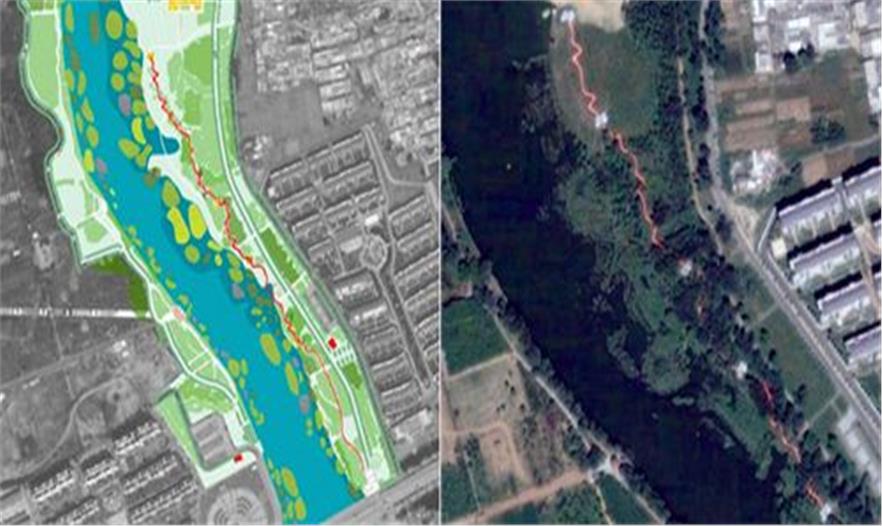
紅飄帶公園:上千米長(zhǎng)的長(zhǎng)椅甚至可以從空中看到�����。
堤岸和河道被修建成公園,并為水體提供了更廣闊的空間�����。沼澤植物比如蓮花�����、蘆葦���、水稻等����,可以為河堤提供自然靈活的防護(hù)���。對(duì)于土人設(shè)計(jì)如此大尺度的項(xiàng)目來說,這種“自然的手段”可以用很短的時(shí)間使大面積被遺棄的土地重?zé)ㄉ鷻C(jī)���。

沈陽建筑大學(xué)校園
在沈陽建筑大學(xué)項(xiàng)目中��,土人設(shè)計(jì)運(yùn)用多產(chǎn)景觀���、自然水灌溉的理念�����,在六個(gè)月內(nèi)就完成了校園的建設(shè)�����。場(chǎng)地原先是一片沖積地��,洪水來襲時(shí)起到緩沖的作用�����,此前種植有水稻和蕎麥����。校園中各個(gè)建筑單體由小徑相連�,并通向?yàn)閷W(xué)生設(shè)置的室外空間里,學(xué)生們可以在那里學(xué)習(xí)�、交談,甚至冥想�。當(dāng)收獲季來臨,生長(zhǎng)在通道兩旁的稻谷可以收割來出售�,收割后的田地還能喂養(yǎng)山羊。
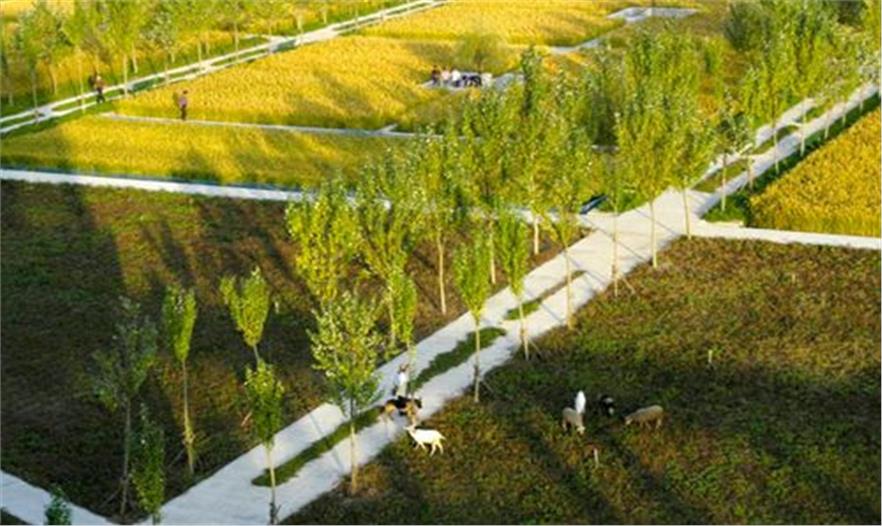
沈陽建筑大學(xué):校園里種植有稻谷和蕎麥���,山羊在收割后校園里覓食����。
瑞士主辦了今年的IFLA大會(huì),無論牛群的散養(yǎng)是否會(huì)使其乳制品工業(yè)更具競(jìng)爭(zhēng)力��,在這個(gè)國家牛羊是景觀的捍衛(wèi)者���,因?yàn)樗鼈兪菢?gòu)成當(dāng)?shù)貍鹘y(tǒng)景觀不可或缺的元素����,同時(shí)也是維持瑞士典型的山地草場(chǎng)和高山草甸生態(tài)多樣性不可替代的角色�。
中國景觀特有的傳統(tǒng)特色則是梯田,層層抬高的田地不僅避免了流水的侵蝕���,同時(shí)能讓水體在一層層的跌落過程中得到凈化���。這種古老的觀念被運(yùn)用到了寧波的一個(gè)80公頃公園當(dāng)中����,這樣,就可以得到約有250,000 m³被植物凈化過的干凈水����。
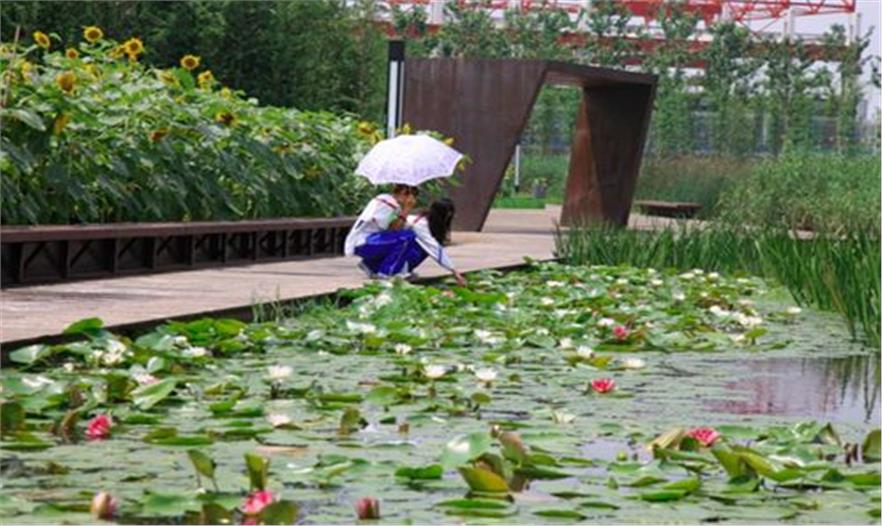
景觀作為生命系統(tǒng)用以凈化水體:上海世博后灘公園
另一個(gè)俞孔堅(jiān)教授喜歡用的更深的隱喻表現(xiàn)在紅飄帶中����,紅飄帶具有裝飾的作用:它不禁錮自然反而可以強(qiáng)調(diào)自然之美�。一條超大尺度的絲帶貫穿了整個(gè)紅飄帶公園,長(zhǎng)達(dá)上千米的坐凳從空中俯瞰時(shí)清晰可見��。盡管其尺度如此之大����,土人設(shè)計(jì)的信條始終是“最小的投入最大的回報(bào)”。與該項(xiàng)目所覆蓋的范圍相比��,紅飄帶僅僅通過對(duì)環(huán)境很小的干預(yù)就鞏固了河岸����,增強(qiáng)了其易達(dá)性,從而成為被自然環(huán)繞的公共休閑場(chǎng)所�����。
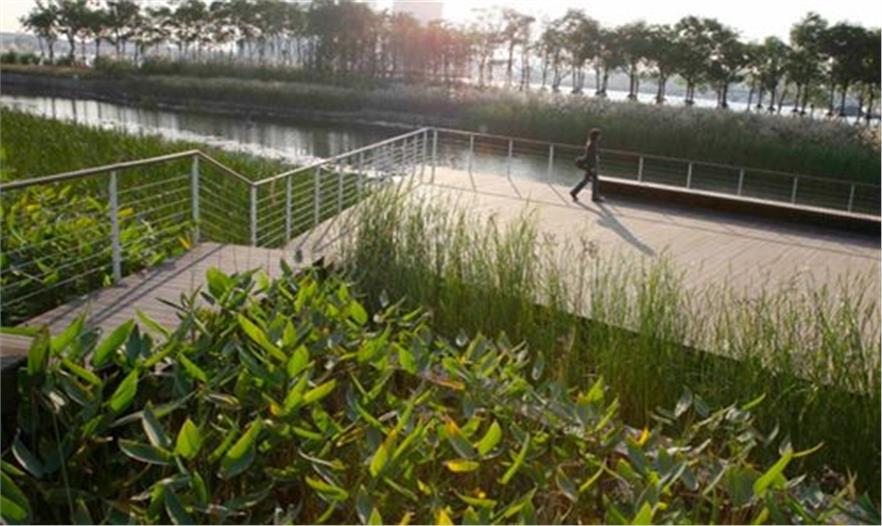
現(xiàn)代版的稻田
土人設(shè)計(jì)目前為全國三分之一的城市政府提供景觀顧問服務(wù)�����,雇員超過六百人。俞孔堅(jiān)教授在北京大學(xué)的景觀設(shè)計(jì)課程的畢業(yè)生也已經(jīng)從兩人增加到兩百人�。就在這個(gè)國家不計(jì)環(huán)境代價(jià)地追求激進(jìn)的工業(yè)化時(shí),人們已經(jīng)開始進(jìn)行反思����。人們犯下了種種錯(cuò)誤,但這些錯(cuò)誤(至少是部分錯(cuò)誤)正在被認(rèn)識(shí)到���。
俞孔堅(jiān)教授在和我談話時(shí)說:“IFLA大會(huì)是景觀設(shè)計(jì)行業(yè)最為重要的會(huì)議”�����,他笑了笑�����,“在蘇黎世舉行這次議會(huì)真的是太棒了���,雖然你們這里無需做什么事情,畢竟瑞士已經(jīng)是個(gè)引人入勝的地方了�。過程也許是緩慢的,但沒有犯過重大的錯(cuò)誤�?����!被蛘咭苍S這些問題已經(jīng)被發(fā)現(xiàn)并改正了。
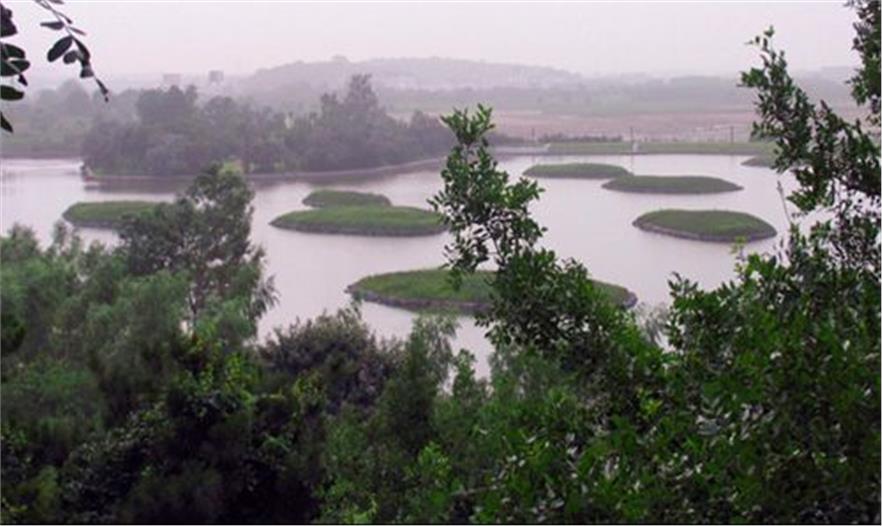
天津橋園公園:廢棄地的生態(tài)修復(fù) 用以提供多種生態(tài)服務(wù)
點(diǎn)此訪問IFLA全球大會(huì)網(wǎng)站
附原文:

Author
Susanne Fritz
Zürich, Switzerland
Professor Kongjian Yu, founder of Turenscape Landscape Architects, is one of the world’s leading landscape designers. He gave a revolutionary lecture at the IFLA congress in Zurich, entitled ’Reinventing the good earth’.
Prof. Kongjian Yu, founder of Turenscape Landscape Architects, is one of the world's leading landscape designers. His concept of functional landscape architecture shows astounding parallels to the contemporary definition of Swiss agriculture, the main aim of which long ago went beyond simply supplying the country with agricultural produce. Ecology and custody of our cultural landscape, which is by us perceived as nature, are becoming ever more important.
"Minimize Intervention and maximize Return” - a rational description of the very poetic project "Red Ribbon Park"
Prof. Kongjian Yu's address to a large audience in Zurich's Kongresshaus began with a retrospective journey through his life. Born in China in the 1960s, he came from a farming background. This influenced his perception of the interconnections between nature and the cultivation of the landscape. He believes that the latter can only produce a good yield if it adapts itself to the conditions imposed by the former – an ecological and economic approach which is the dominant feature of his landscape planning.
Among hundreds of candidates from the whole of China Kongjian Yu was one of 60 students to be given the opportunity of studying garden design – for him an ironic development because his previous dealings with plants had been in terms of earning a living rather than aesthetic pleasure. On a journey through China after completing his studies he perceived the condition of the environment as critical and made the decision to dedicate himself to finding solutions to the problem. He received a grant to study at Harvard University and, armed with his doctorate, this polite and modest man returned to China with an objective which was no less than the 'Big Foot Revolution'.
The metaphor of red ribbon has a decorative feature in that it does not confine nature but serves to highlight its beauty

The illumination of the bench at night is not only romantic but also provides safety to the path
The 'Big Foot Revolution' is a metaphor which is derived from overcoming the oriental custom of deforming women's feet. It is based on the perception that aspects of civilisation which suppress nature represent a waste of resources. In contrast, forms of civilisation which operate in harmony with ecological principles and the sensible application of natural laws are much more productive.
Prof. Kongjian Yu developed simple but revolutionary solutions. By means of 'productive plants' which are native to the region it is possible to landscape large areas and create fields. The 'disorderly' plants, as Yu describes them, don't need to be pruned and watered, and they have a natural beauty. Sunflowers and rice have a symbolic character – and their fruits can be harvested.
Red Ribbon Park project: The kilometre long bench can even be seen from space
Embankments and canals are replaced by parks which provide space for water. Marsh plants such as lotus, reeds and rice provide natural and flexible reinforcement for the shoreline. For the giant dimensions of the Turenscape Landscape Architects projects these 'natural' solutions represent a method of revitalising large, desolate areas within a short space of time.
Shenyang Architectural University Campus
For the Shenyang Architectural University project Turenscape Architects took advantage of this concept of productive planting and natural water regulation, creating the campus landscape within only six months. The site was declared to be alluvial land, a buffer zone for floodwater, and rice and buckwheat were planted on it. Narrow paths connect the individual buildings on the campus and lead to platforms which provide space in the open air for study, debate and even meditation. Once it has been harvested the rice can be purchased, while goats feed on the plant residues left on the site after the harvest.
Shenyang Architectural University: rice and buckwheat were planted, goats feed on the plant residues left on the site after the harvest
In Switzerland, which this year is hosting the IFLA, cows and goats are 'custodians of the landscape', regardless of whether the dairy industry can be managed competitively with free-ranging cattle. They are part of our landscape tradition and maintain the biodiversity of our typical upland pasture and alpine meadows.
In contrast the characteristic traditional feature of the Chinese landscape is the paddy fields which counteract the erosion of the slopes and at the same time have a purifying effect on the water as it trickles downwards. This ancient principle has been applied in Ningbo within an 80-hectare park, with filtration of the water which seeps through the plants enabling 250,000 m³ of clean water to be obtained.
Landscape as a living machine to clean polluted water: Houtan Park of Shanghai Expo
A further metaphor which Prof. Kongjian Yu likes to use is in the red ribbon, which has a decorative feature in that it does not confine nature but serves to highlight its beauty. A ribbon of supernaturally large dimensions runs through the Red Ribbon Park project. The kilometre long bench can even be seen from space. In spite of this the slogan of Turenscape Architects is 'Minimize Intervention and maximize Return'. Measured against the size of the area which has been landscaped the bench represents a real enhancement to the riverbank with minimal intervention, making it accessible to people and turning it into a promenade in the heart of natural surroundings.
Modern version of paddy field
Turenscape now advises one third of the mayors of Chinese cities and employs a workforce of over 600. Prof. Kongjian Yu's course in landscape architecture at Peking University has grown from 2 to 200 graduates. Just as fast as the country pursued a course of radical industrialisation without any regard for its cost to the environment, a major rethink now seems to have taken place. Mistakes have been made, but they are (at least in part) also being recognised.
In the course of our conversation with Prof. Kongjian Yu he commented: "The IFLA is the most important congress for landscape architecture," adding with a smile "It's great that it is taking place here in Zurich – even though there's not much for you to do here, everything is already very attractive. The processes may be slow, but no major mistakes are made." Or perhaps they have already been identified and corrected.
Tianjin Qiaoyuan Park: Ecological recovery of a deserted site for multiple eco-services


 京公海網(wǎng)安備 110108000058號(hào)
京公海網(wǎng)安備 110108000058號(hào)


























